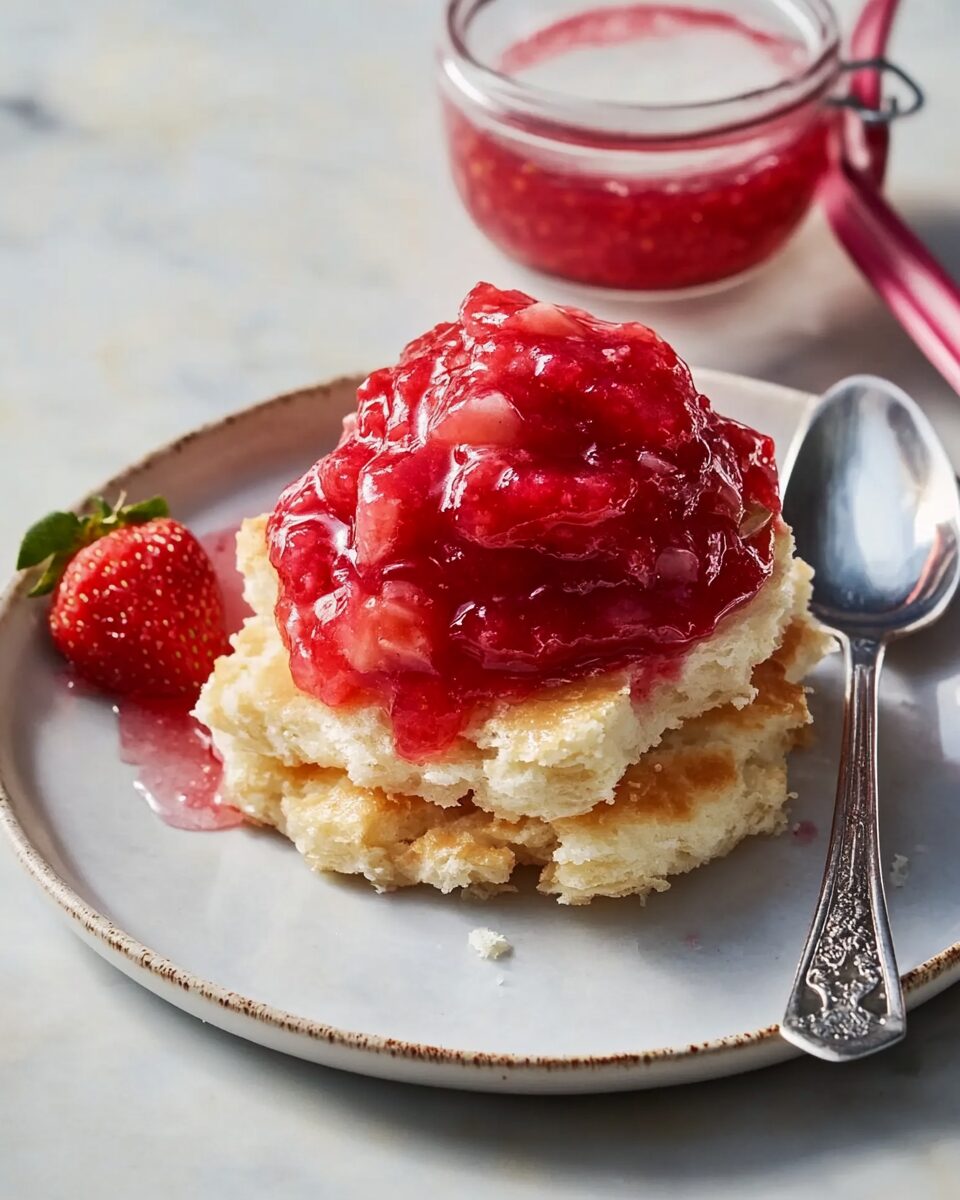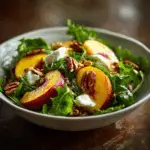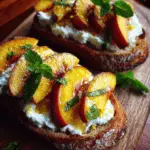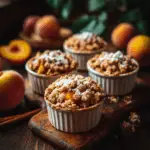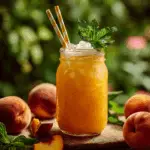Strawberries and rhubarb are a quintessential spring pairing, and making jam with them is a wonderful way to preserve their bright flavors long after the season is over. This recipe balances the tartness of rhubarb with the sweetness of strawberries and sugar, resulting in a delightful spread perfect for topping ice cream, yogurt, or filling cakes.
FULL RECIPE
Ingredients:
- 5 cups chopped rhubarb (approximately ten 12-inch stalks)
- 3 cups quartered, hulled strawberries (about 1 pound)
- 2 1/2 cups sugar
- Zest of 1 lemon
- 2 tablespoons lemon juice
- 3/4 teaspoon kosher salt
Directions:
- In a large saucepan, combine rhubarb, strawberries, sugar, lemon zest, lemon juice, and salt. Lightly mash to release some berry juice. Let sit for 10 minutes to macerate and dissolve sugar.
- Place a small plate in the freezer to chill for testing jam consistency later.
- Heat the saucepan over medium-high heat. Cook, stirring frequently, until the mixture reaches a full boil.
- Continue cooking, stirring often, until the jam thickens and reaches 218°F to 220°F on a candy thermometer, approximately 20 to 25 minutes.
- To test consistency, place a small spoonful of jam on the chilled plate and return to the freezer for 1 minute. If it wrinkles when pushed with a finger, it’s ready.
- Once ready, remove from heat and let cool for 10 minutes.
- Transfer the jam into clean jars, leaving about 1/4-inch headspace.
- Seal jars and let cool to room temperature. Store in the refrigerator for up to 3 weeks.
Nutrition Facts
- Calories: 367
- Carbohydrates: 94g
- Dietary Fiber: 3g
- Sugars: 88g
- Protein: 1g
- Sodium: 598mg
The History of Strawberry Rhubarb Jam
Strawberry rhubarb jam has been a beloved homemade preserve for generations. Rhubarb, originally cultivated in China for medicinal purposes, made its way to Europe and later North America, where it became a popular ingredient in pies, sauces, and jams. The combination of rhubarb and strawberries became particularly well-loved in the United States and Canada, where both ingredients are commonly grown and harvested during the same season. This jam is a wonderful way to preserve the flavors of spring and early summer, ensuring their tart and sweet balance can be enjoyed year-round.
Why Rhubarb and Strawberries Are the Perfect Pair
Rhubarb is known for its intensely tart flavor, which can be overwhelming on its own. However, when paired with the natural sweetness of strawberries, the result is a harmonious blend of flavors. The strawberries add a juicy, fruity essence that balances the sharpness of rhubarb, while the rhubarb provides a slightly tangy depth that prevents the jam from becoming overly sweet. Together, they create a rich and vibrant preserve that can be used in countless ways.
The Science Behind Thickening Jam
Jam thickens due to a combination of sugar, pectin, and heat. Rhubarb naturally contains some pectin, but not enough to create a firm-set jam without additional sugar and acidity from lemon juice. As the jam cooks, the heat breaks down the fruit’s structure, releasing water and allowing the sugars to concentrate. This process helps the mixture reach the gel-like consistency associated with jam. The lemon juice not only enhances the flavor but also contributes to the gelling process by adjusting the pH balance, making it easier for the pectin to set properly.
Best Ways to Store Strawberry Rhubarb Jam
After cooking, strawberry rhubarb jam should be stored properly to maintain its freshness and flavor. If kept in sterilized, airtight jars and refrigerated, the jam will last for up to three weeks. For longer storage, the jam can be processed in a water bath canner, allowing it to be kept at room temperature for up to a year. Freezing is another option, ensuring that the jam retains its bright color and taste for several months.
Common Mistakes When Making Jam
One of the most common mistakes is overcooking or undercooking the jam. Overcooking can result in a jam that is too thick and caramelized, while undercooking can leave it runny. Another mistake is not using enough sugar, which is essential for preservation and texture. Failing to test the jam’s consistency by chilling a sample on a cold plate can also lead to an inconsistent final product.
How to Achieve the Perfect Texture
The key to achieving the ideal jam texture is patience and careful monitoring. Cooking at a consistent medium-high heat while stirring frequently ensures that the mixture reduces evenly. Using a candy thermometer to check that the jam reaches between 218°F and 220°F is a reliable way to confirm the proper consistency. If the jam still seems too thin, continuing to cook for a few extra minutes can help it thicken without becoming too firm.
Alternative Sweeteners for a Healthier Jam
While traditional jam recipes rely on granulated sugar, there are several alternative sweeteners that can be used to make a healthier version. Honey provides a floral sweetness and a slightly softer texture, while maple syrup adds a subtle caramel flavor. Coconut sugar or unrefined cane sugar can also be used, though they may slightly darken the jam’s color. Some people opt for low-calorie sweeteners such as stevia or monk fruit, but these may not provide the same thickening properties as sugar.
How to Use Strawberry Rhubarb Jam in Recipes
This jam is incredibly versatile and can be used in numerous ways beyond spreading on toast. It makes an excellent topping for pancakes, waffles, or yogurt. It can also be used as a filling for cakes, pastries, and thumbprint cookies. Swirling it into ice cream or using it as a glaze for roasted meats like pork or chicken creates a delicious balance of sweet and savory flavors.
The Best Type of Strawberries to Use
For the best flavor, choose ripe, in-season strawberries. Fresh, locally grown strawberries tend to be sweeter and more aromatic than out-of-season, store-bought varieties. If fresh strawberries are not available, frozen strawberries can be used, but they may contain more water, requiring additional cooking time to achieve the right consistency.
Can You Make Jam Without Sugar?
It is possible to make a lower-sugar or sugar-free version of strawberry rhubarb jam, but adjustments need to be made. Because sugar acts as a preservative, omitting it entirely means the jam will have a shorter shelf life. Using a pectin designed for low-sugar recipes can help achieve the right texture. Additionally, natural sweeteners like fruit juice concentrates or mashed bananas can add sweetness without the need for refined sugar.
How to Achieve a Brighter Color
The key to maintaining a vibrant red color in strawberry rhubarb jam is to use fresh ingredients and avoid overcooking. Adding lemon juice not only enhances flavor but also helps preserve the jam’s natural brightness. Cooking the jam over medium heat instead of high heat can also prevent caramelization, which can cause the color to darken.
Pairing Jam with Other Ingredients
Strawberry rhubarb jam pairs beautifully with a variety of foods. It complements cheeses like brie, goat cheese, or cream cheese when spread on crackers or sandwiches. It also works well with peanut butter, adding a tangy contrast to the nutty richness. For a sophisticated dessert, it can be drizzled over panna cotta, cheesecake, or layered into parfaits.
The Difference Between Jam, Jelly, and Preserves
Many people confuse jam, jelly, and preserves, but they each have distinct characteristics. Jam contains crushed fruit and has a slightly chunky texture. Jelly is made from fruit juice and is completely smooth. Preserves contain larger fruit pieces, sometimes left whole, resulting in a thicker and chunkier consistency. Strawberry rhubarb jam falls in between jam and preserves, as the rhubarb softens while cooking but retains some texture.
How to Make Jam Without Pectin
While pectin can help jam set more quickly, it is not necessary when making strawberry rhubarb jam. The natural pectin in the fruit, combined with sugar and lemon juice, is enough to create a good consistency. Cooking the jam longer allows the water to evaporate, concentrating the natural pectin and creating a thick, spreadable texture.
How Long Does Homemade Jam Last?
If properly sealed and stored in the refrigerator, homemade strawberry rhubarb jam can last up to three weeks. If processed using a canning method, it can last up to a year in a cool, dark place. Once opened, it should be refrigerated and used within a month for the best quality.
Can You Freeze Strawberry Rhubarb Jam?
Yes, freezing is an excellent way to store jam for an extended period without canning. To freeze, pour the jam into freezer-safe containers, leaving some space for expansion. Frozen jam retains its flavor and color well and can last for up to a year. Thaw in the refrigerator overnight before using.
Making Small Batch Jam vs. Large Batch Jam
Small-batch jam is ideal for those who want fresh jam without the need for long-term storage. It also allows for more control over consistency and flavor. Large-batch jam requires more careful monitoring to ensure it thickens evenly and doesn’t scorch.
The Best Tools for Making Jam
A heavy-bottomed saucepan ensures even cooking, preventing burning. A candy thermometer helps monitor the temperature for perfect consistency. Sterilized jars are necessary for long-term storage. A potato masher can be used to break down fruit while cooking.
Conclusion
Strawberry rhubarb jam is a delightful combination of sweet and tart flavors that can be enjoyed in countless ways. Whether spread on toast, used in desserts, or paired with savory dishes, its versatility makes it a must-have for any kitchen. With the right techniques and ingredients, making homemade jam is a rewarding process that preserves the best flavors of the season.

